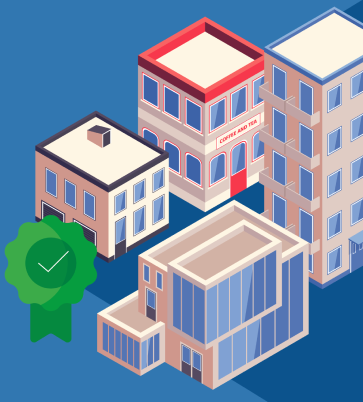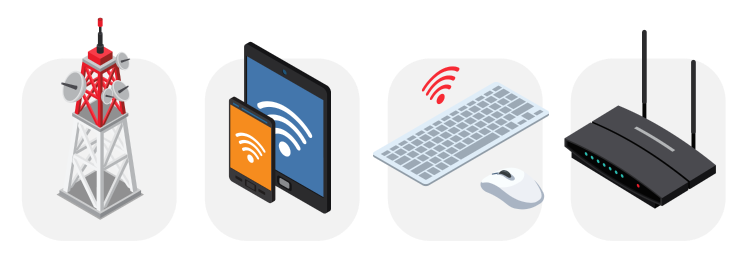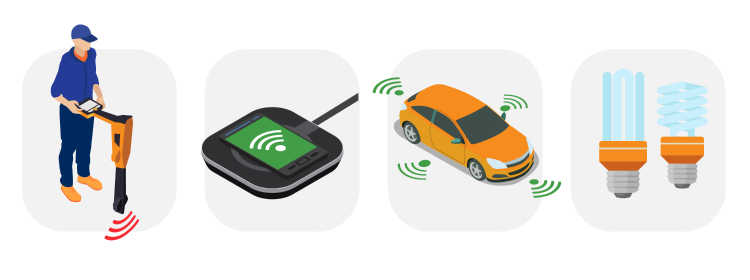Radio and wireless communication is all around us
Have you ever wondered how wireless devices, radio apparatus and other equipment can operate without interference? This is because they comply with Canadian technical standards. This video provides an overview of what is required to ensure that all equipment operating on Canada's spectrum is compliant with the Canadian technical standards.
Transcription – Radio and wireless communication is all around us
[Music starts]
[Animation starts from above the clouds and moves down to the city landscape. In the background cell towers with wireless signal pulses. Zoom in to a busy street, people are walking and talking on their mobiles, cars are passing by emitting wireless signals. Wireless waves are shown as connectivity is happening around everybody.]
Female Narrator: Radio and wireless communication is happening all around us.
[View flips to people inside their apartments showing a family connecting on a video call.]
Female Narrator: It allows us to be more productive and more connected than ever before.
[Scene changes to inside a generic electronics store where people are shopping. Customer has a device in hand]
[Text on screen:
Canadian Technical Standards]
[Green checkmark appears with safety representation]
Female Narrator: This is possible because equipment made in, or brought into Canada must comply with technical standards ensuring they are safe for Canadians to use, and minimize the risk of harmful interference.
[Scene changes to inside an office where people are working on design sketches for a device. Zoom in to a clipboard with the word "Standards" at the top and a non-readable list of checked items.]
Female Narrator: If you're a manufacturer or importer and you plan to bring equipment to the Canadian market, you're responsible for ensuring it meets Canadian standards.
[Camera turns to a projection screen that shows image with two categories of equipment.]
Female Narrator: Equipment falls into different categories, you will need to certify, register or self-declare your product and label it accordingly.
[Graphic slides down and the URL www.canada.ca/radio-equipment-standards appears at the center of the screen.]
Female Narrator: Visit www.canada.ca/radio-equipment-standards...
[The Categories graphic slides back up, the URL slides to the top of the screen.]
Female Narrator: to familiarize yourself with the standards and learn which ones apply to your product.
[Scene switches to a testing laboratory for electronic devices. A device is in an anechoic style chamber.]
Female Narrator: To ensure that your product meets the technical standards, you can use a recognized testing lab to verify it complies.
[Camera moves to the right, where another character is preparing a report while seated beside an oscilloscope.]
Female Narrator: The lab will provide a detailed test report indicating if you are in compliance with all relevant standards.
[Scene goes to inside a factory showing an assembly line of product being packaged. Worker is labelling the boxes which display a green checkmark.]
Female Narrator: Once compliant, the final step is to obtain any necessary certification or registration, and label your product appropriately.
[Scene flips to a truck loaded with boxes of the product.]
Female Narrator: Congratulations! Your product is now ready for the Canadian market.
[The truck drives away from the factory and arrives to a generic electronics store on a busy street with wireless signals pulsing from everywhere. A Canadian flag is on the roof of the store.]
Female Narrator: Through these standards, we're working together to keep Canadians safe, productive and more connected than ever before…
[Camera starts zooming up to the sky, an airplane flies over the screen, closing the scene and morphing the view to a white screen with a maple leaf in the background.]
Female Narrator: For up-to-date information on the standards as well as listings of recognized test labs & certification bodies, please visit www.canada.ca/radio-equipment-standards
[Text on screen:
For more information on the Standards and listings of Recognized Test Labs & Certification Bodies, visit: www.canada.ca/radio-equipment-standards.]
[ISED signature]
[Canada wordmark]
[Music ends]
Technical Equipment Standards and Canada’s Radio Spectrum
The Spectrum and Telecommunications Sector of Innovation, Science and Economic Development Canada (ISED) manages Canada’s spectrum environment including its radio equipment ecosystem, to ensure safe and seamless connectivity.
Through the development of radio equipment and interference-causing equipment standards, procedures and technical guidelines for the resolution of interference complaints, we support efficient and safe operation of Canadian telecommunication and radiocommunication services.
We conduct technical consultations with stakeholders, including international trade partners through the World Trade Organization on the standards we develop.
Our activities also include the recognition and designation of conformity assessment bodies, which are engaged in the performance of procedures for determining whether the relevant requirements in technical regulations or standards are fulfilled. We monitor international developments to support trade and ensure a vibrant Canadian marketplace through the facilitation of latest technologies introduction.
ISED supports new technology innovations in many ways, notably through RSP-102 procedure which outlines Special authorization request requirements. As well as through the Developmental Licence Playbook which allows innovators access to spectrum to test their new business ideas.
Manufacturers, innovators and importers have a responsibility to understand that the products they bring to the Canadian market must comply with technical equipment standards in Canada.
Categories of equipment under ISED’s standards
Under the Radiocommunication Act and the Radiocommunication Regulations two categories of equipment are identified. Category I radio equipment falls under a certification scheme and Category II equipment falls under a Supplier’s Declaration of Conformity scheme.
Under the Telecommunication Act, telecommunication (or terminal) equipment that attaches to telecommunication networks of Canadian carriers falls under a registration regime.
Category I equipment
These devices must undergo Certification which involves obtaining a Technical Acceptance Certificate (TAC) issued by an ISED recognized Certification Body and listed in ISED's database, the Radio Equipment List (REL). This process confirms that the equipment complies with the applicable standards, which was tested by an ISED recognized Testing Laboratory.
Depending on the applicable standard(s), Category I equipment can be either licenced or licence-exempt. A licence sets out the conditions to operate the equipment, where applicable. The licensing process is undertaken separately from the certification process. ISED regional offices may help with licencing enquiries. On the other hand, licence-exempt equipment does not require a licence to operate the device.
Examples of Category I equipment include: broadcast transmitters, taxi and police push-to-talk radios, point-to-point broadband links (used for backhaul), cellular networks and cellphones, and most wireless consumer products such as Wi-Fi devices, baby monitors and Bluetooth devices. These devices must be labelled with the certification number they are given.
Category II equipment
These devices do not have to obtain a TAC. However, they are still required to meet technical standards which include technical and administrative requirements. These devices can be licence-exempt, as is the case for Interference-Causing Equipment.
Examples of Category II equipment include: very low power transmitters and standalone receivers, satellite receivers, and most consumer electronic devices that unintentionally produce radio frequency emissions, such as computers, DVD players, vehicle ignition systems, etc. These devices must be labelled, which represents the Supplier’s Declaration of Conformity (SDoC), confirming that the equipment complies with the applicable standards.
Terminal Equipment
Terminal equipment requires testing performed by an ISED recognized laboratory, a Declaration of Conformity and registration with the Certification and Engineering Bureau (CEB). In this case, the supplier declares that the equipment is compliant with the applicable technical regulations to ISED and the CEB then registers the equipment in the Telecommunication Apparatus Register (TAR). Terminal equipment are referred to in the Act as telecommunications apparatus that can be connected to networks of Canadian carriers and used by a telecommunication service subscriber at their premises. Examples of terminal equipment include: analog and VOIP phones, modems, DSL equipment.
Access the Terminal equipment – Technical Specifications list (CS-03)
How do the technical equipment standards apply to the work you do?
Manufacturers or innovators who create new products and want to bring them to the Canadian market must ensure their products comply to specific technical standards established by ISED, including those related to RF exposure compliance (or RF safety). It is important to be mindful of these standards early in the developmental stage of the product and to stay aware of standard development activities as new rules come up.
Importers and distributors are also responsible for ensuring the products they bring to the Canadian market comply to ISED's technical standards, including those related to RF safety.
Step 1: Familiarize yourself with ISED equipment regulations

Determine which standards apply to your product, keeping in mind that there may be more than one. For example, a cellular handset may need to conform to a number of Radio Specification Standards such as RSS-192 - Flexible Use Broadband Equipment Operating in the Band 3450-3650 MHz, RSS-Gen - General Requirements for Compliance of Radio Apparatus, and RSS-HAC - Hearing Aid Compatibility and Volume Control, as well as ensuring that the radio frequency (RF) energy is within the prescribed limits of RSS-102 - Radio Frequency (RF) Exposure Compliance of Radiocommunication Apparatus (All Frequency Bands).Another product may only need to meet the requirements of an Interference Causing Equipment Standard, such as ICES-003 - Information Technology Equipment (including Digital Apparatus) and the associated ICES-Gen - General Requirements for Compliance of Interference-Causing Equipment.
Step 2: Have your product tested to ensure compliance

To ensure that your product meets the technical requirements, you will need to have it tested by a laboratory. Depending on device type, testing may need to be done by an ISED recognized testing laboratory. You can submit your product to one of these recognized laboratories. They will advise on the applicable technical standards and undertake the testing. They will, for a fee, complete testing and create detailed reports that they will give to you.
Under special circumstances, if your product does not meet all the requirements in the applicable technical equipment standards, it may still be approved for use in Canada through a Special Authorization. For more information on this, consult RSP-102 - Special Authorization Procedure for Terminal Radio, Broadcasting and Interference-Causing Equipment to be Certified, Registered or Deemed in Compliance with Technical Equipment Standards.
Step 3: Certify, register or self-declare your equipment

The following step determines the appropriate action to take with the test report. This step depends on the product's category. Earlier, we explored Category I and Category II radio equipment and Terminal Equipment.
- If a product is Category I radio equipment:
- Send the test results report from Step 2 to an ISED recognized Certification Body.
- Certify the device by obtaining the TAC from the Certification Body.
- Ensure the equipment is listed in the Radio Equipment Listing (REL) database with ISED.
- Label the equipment accordingly, including the certification number.
- If a product is Category II radio equipment:
- Keep the test reports as proof that the equipment met the requirements of the appropriate standard(s). ISED may request a copy of the test report.
- Label the product indicating that you confirm it meets the standard(s). This is what is known as the Supplier’s Declaration of Conformity (SDoC).
- If a product is Terminal Equipment:
- Ensure the test report is submitted to ISED.
- Ensure the procedure for declaration of conformity and registration is completed.
You are ready to place your product on the Canadian market

You may now manufacture, import, distribute, lease, offer for sale and sell your product. At this point, you are now responsible for ensuring that the product continues to meet ISED's standards. If there are amendments or changes to the standards (i.e., new issues), you will need to make sure your products continue to conform to the amended / modified standards. In some cases, this may mean re-testing some or all aspects of your product.
If there are any complaints or issues with the equipment, for example, if it is causing interference with other services or products, you will be required to co-operate in investigations. In the case of Category II equipment, this may involve providing the test reports detailing the product’s technical performance to help determine where any issues may exist.
For further information regarding this topic, we invite you to consult our Common Q&A


